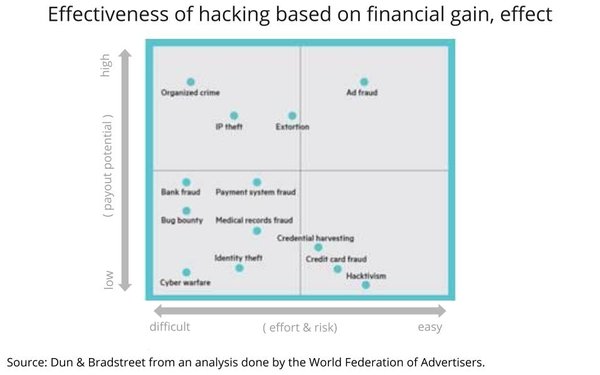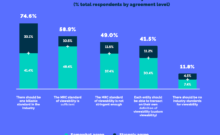When one thinks of organized criminal activity, it is often unsavory activities involving trafficking of some form, but fraudulent web traffic is rapidly growing as a high reward, low risk, low effort criminal pursuit. Last year, the World Federation of Advertisers (WFA) concluded that within a decade, online advertising fraud is likely to be the second most lucrative criminal activity, trailing only opiate and cocaine trafficking.
The WFA projected web advertising to be a half trillion-dollar industry in 2025 and then projected a 10 percent fraud rate, arriving at $50 billion as the economic impact of fraudulent activity. Ad fraud is not only parasitic theft, but a source of easy funds for organized crime, terrorist groups and hackers.
When Hewlett Packard Enterprises evaluated various forms of hacking across two dimensions (Payout Potential versus Effort and Risk), ad fraud was the clear winner across both dimensions, easily beating out extortion, credit card fraud, IP theft and other fraudulent activities. It is clear that increasing the difficulty in carrying out fraudulent activities and/or reducing the economic benefit of a fraudulent activity is imperative if we are to deter the bad actors.
As advertising has shifted to programmatic advertising and real-time bidding, the increase in volume of transactions made possible by these technologies inadvertently make it relatively easier to carry out fraudulent activities. The advertising industry needs to adopt a series of strategies which help combat fraud and ensure digital advertising is both legitimate and brand safe.
Not only does online advertising fraud represent a deadweight loss to advertisers, but it can result in brand harm when advertising is placed next to objectionable content or malvertising. In a recent study, nearly 70% of respondents said brand safety has become more important to their businesses. With programmatic marketing, advertisers are looking to ensure that ads will be displayed on brand safe networks, not “fake news” sites with fringe or hateful content.
Read More at The Original Article: www.mediapost.com









